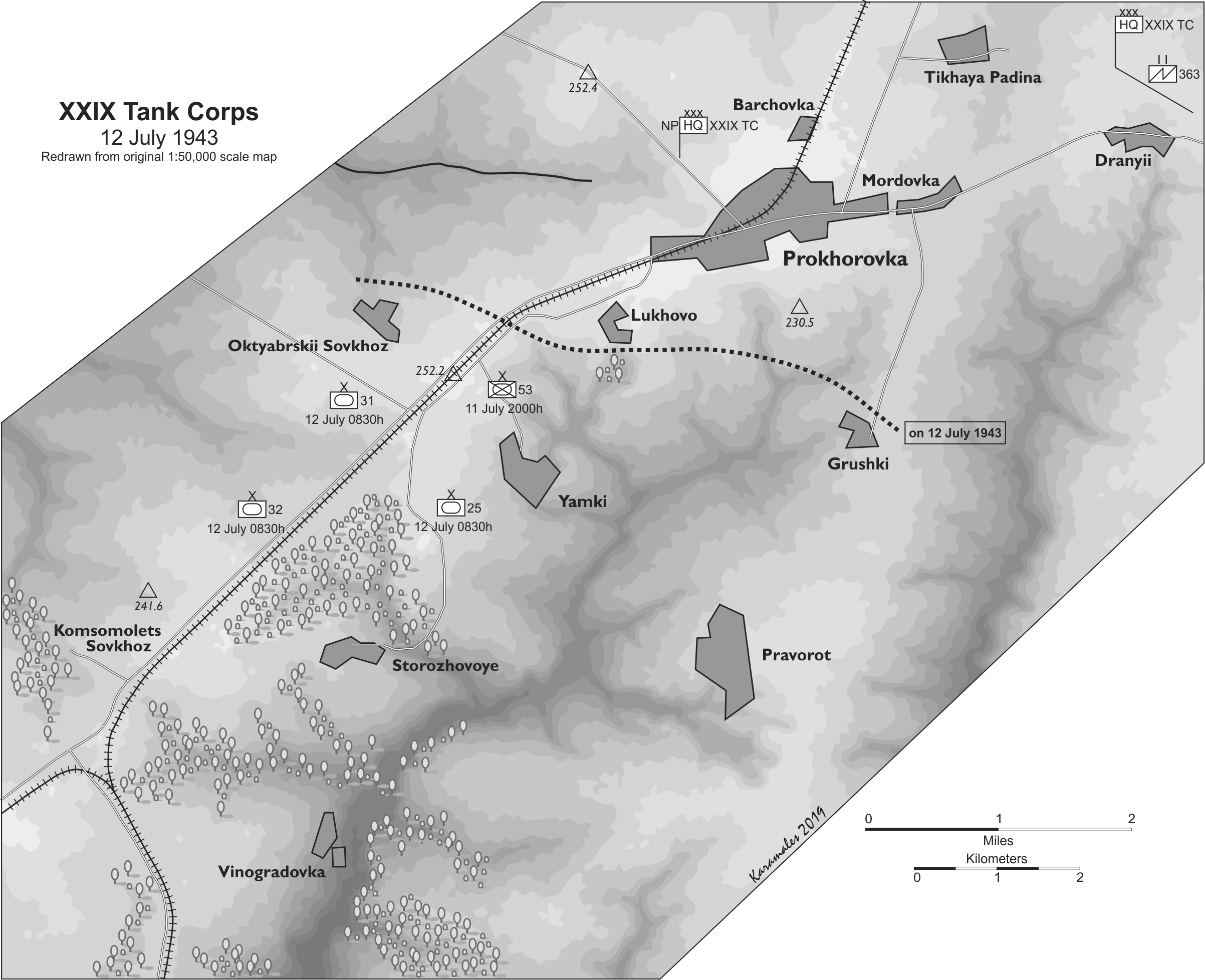
Seems like I never quite get away from the Battle of Kursk and move onto other work. As a result of piece I was working on, I ended up checking back in my files. This material below is quoted (translated) from a narrative of events kept by the SS Panzer Corps (file T313, R368). For 12 July 1943 they report:
0500 hours: Morning reports
LSSAH: Contact with Totenkopf established. Numerous tank noises along our front. Heavy enemy air activity.
Das Reich: Night passed quietly. Regiment Deutschland is ready to follow the right wing of LSSAH’s attack.
Totenkopf: Strong artillery and small arms harassing fire, heavy enemy air activity.
0600 hours: Enemy attack in regimental strength along the line Prochorowka-Petrowka drive off on LSSAH’s front.
0740 hours from Totenkopf:
0630 hours slow infiltration of the flank positions at the barracks (west of Klljutschki). Very heavy artillery and salvo-gun fire. Advance to the northeast still not specified.
0740 hours from Totenkopf:
0705, very heavy infantry [attack?] 3 km east of Petrowka.
0822 hours from Totenkopf:
Two enemy regiments and about 40 tanks from the northeast, observed entering Michailowka and hills to the southeast at 0745.
0825 hours from Totenkopf:
0740 hours, an enemy battalion attacking into the Psel area from the north.
0900 hours from Totenkopf:
Last elements crossed over into the bridgehead at 0900. Using the panzer battalion that crossed over yesterday, began advancing against the barracks at 0400 hours. Barracks captured by 0715.
0910 hours from VIII Air corps:
Two Stuka groups have been dispatched against the enemy group moving southwest from Petrowka.
0955 hours from Totenkopf:
Enemy attacking west from Michailowka with tank support.
At 0930 hours our armored group jumped off from Hill 226.6 to the northeast.
1000 hours from LSSAH:
Enemy attacks on all fronts (At 0915 hours, 40 tanks from Jamki against Swch. Stalinsk, 35 tanks from Prochorowka along the road to the southwest, 40 tanks from Petrowka against Swch. Oktjabrskij, and the heaviest artillery support).
1110 hours from Totenkopf:
Enemy attack in regimental strength out of Wassiljewka to the southwest. Additional attacks south of Wesselyj and Ilinskij.
Aerial reconnaissance reports the advance of additional enemy forces, predominantly infantry, in the area south of Oboojan.
1115 hours from Totenkopf:
We will attempt to cross the Psel at Michailowka and move in behind the enemy that is south of the river.
1130 hours from LSSAH:
Localized enemy breakthrough at Hill 252.2
1145 hours from Das Reich:
Enemy attack against Kalinin and west of Storoshewoje. After repelling this attack, we plan to counterattack to seize Storoshewoje.
1315 hours from LSSAH:
[Enemy] breakthrough taken care of, all infantry attacks driven off.

Just for reference: The LSSAH is the Adolf Hitler SS Panzer Grenadier Division. It was located to the southwest of Prokhorovka. The Das Reich is the Das Reich SS Panzer Grenadier Division which was located to the south (right flank) of LSSAH. Totenkopf is the Totenkopf SS Panzer Grenadier Division which was located to the north (left flank) of LSSAH and was across the Psel River. The Russian names above are as transliterated into German (vice English).
German records were reported in “Berlin time” while Soviet records were reported in “Moscow time.” It is my understanding that at this time of the year in July 1943, Berlin time was one hour behind Moscow time.
Now, I ended up looking this back up because there is an author (Toeppel) who claims that the Soviet attack that their records state occurred at 0830 (Moscow time) actually occurred at 1000. I have in the past been dismissive of this claim, but wanted to make sure I properly examined it. I will address this in more detail in a post tomorrow morning.

What do you think about Toeppel’s Kursk book in general? It was well received in Germany and offered some substantial findings (e.g. on the weather conditions or the designer of Zitadelle).
I have not reviewed it yet.